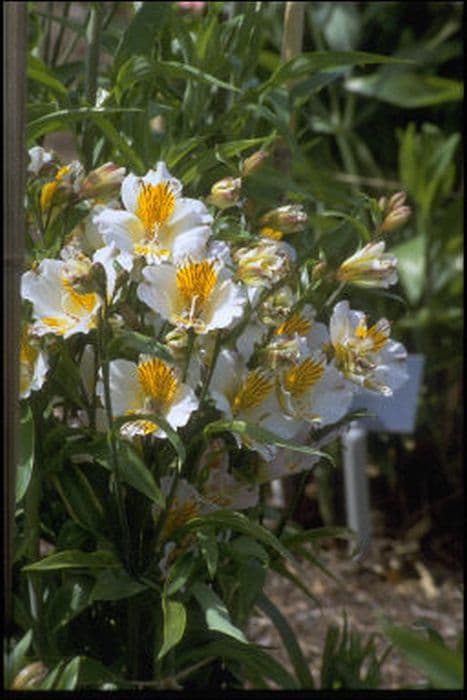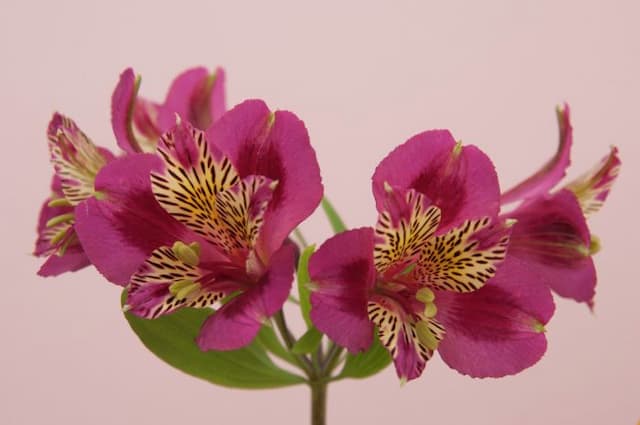Peruvian Lily Alstroemeria 'Orange Glory'
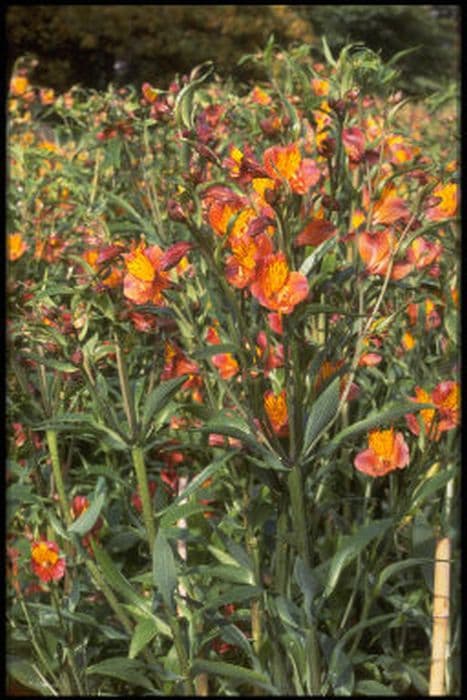
ABOUT
Alstroemeria 'Orange Glory', commonly known as the Peruvian Lily or Lily of the Incas, is a striking perennial with vibrant, attention-grabbing flowers. The bloom of this plant features a gorgeous array of orange petals that are often adorned with darker, contrasting stripes and speckles. The petals are typically arranged in a symmetrical pattern, giving the flowers a neat, orderly appearance. The Peruvian Lily showcases lush, green foliage that adds to its overall aesthetic appeal. The leaves are usually lance-shaped, with a smooth edge, and can sometimes appear twisted on the stem, adding a curious visual interest to the plant's form. This attractive foliage provides a perfect backdrop for the brilliant orange blossoms, which can appear in clusters, creating a wonderful, eye-catching display. Flowering typically takes place in summer and can last for several weeks, transforming garden spaces with their vivacious colors and lively presence. The blossoms of the 'Orange Glory' not only bring beauty to the garden but are also excellent for cutting, as they have a long vase life, making them a popular choice for floral arrangements. The plant's overall appearance is one that exudes robustness and charm, making it a favorite among gardeners and floral enthusiasts alike.
About this plant
 Names
NamesFamily
Alstroemeriaceae.
Synonyms
Peruvian Lily, Lily of the Incas, Parrot Lily, Alstroemeria.
Common names
Alstroemeria 'Orange Glory'.
 Toxicity
ToxicityTo humans
The Peruvian Lily, as Alstroemeria 'Orange Glory' is commonly known, is not considered highly toxic to humans. However, it can cause mild irritation to the skin, eyes, and mouth if touched or ingested. If the sap makes contact with the skin, it can result in dermatitis. Ingestion of the flowers or leaves may lead to mild gastrointestinal upset, including nausea, vomiting, or diarrhea. It is important to wash hands after handling the plant and to avoid touching your face or eyes to prevent irritation.
To pets
Peruvian Lily has a low level of toxicity to pets, such as dogs and cats. If ingested, it can cause mild gastrointestinal irritation, which may present as vomiting or diarrhea. In most cases, the signs are self-limiting and may resolve without the need for veterinary intervention. However, if your pet consumes a large amount of the plant or if symptoms persist, it is important to seek veterinary care to ensure their well-being.
 Characteristics
CharacteristicsLife cycle
Perennials
Foliage type
Evergreen
Color of leaves
Green
Flower color
Orange
Height
2-3 feet (60-90 cm)
Spread
1-2 feet (30-60 cm)
Plant type
Bulb
Hardiness zones
7
Native area
South America
Benefits
 General Benefits
General Benefits- Long flowering period: Alstroemeria 'Orange Glory', commonly known as Peruvian Lily, often blooms from late spring until frost, providing continuous color in the garden.
- Attracting pollinators: The vibrant flowers attract bees, butterflies, and hummingbirds, supporting local ecosystems.
- Cut flower longevity: The Peruvian Lily's blooms last a long time in vases, making them perfect for floral arrangements.
- Drought tolerance: Once established, it is relatively drought-tolerant, making it suitable for water-wise gardens.
- Vibrant color: The bright orange blooms add a splash of color to garden beds, borders, and containers.
- Easy propagation: They can be easily propagated through division, allowing gardeners to create more plants for other areas or to share with friends.
- Minimal pest issues: The Peruvian Lily has few problems with pests, reducing the need for chemical interventions.
- Cold hardiness: It is reasonably resistant to colder temperatures, making it a good choice for many temperate climates.
 Medical Properties
Medical PropertiesThis plant is not used for medical purposes.
 Air-purifying Qualities
Air-purifying QualitiesThis plant is not specifically known for air purifying qualities.
 Other Uses
Other UsesAs a natural dye: The petals of the Peruvian lily can be used to create a natural dye for fabrics or paper, producing a range of colors from yellow to orange, depending on the mordant used.
Culinary garnish: Though not widely known, the petals of the Peruvian lily are edible and can be used to add a splash of color and a mild floral flavor when garnishing salads or desserts.
Photography subject: The vibrant colors and intricate patterns of the Peruvian lily make it an excellent subject for macro photography, helping photographers to capture the beauty of nature.
Crafts and scrapbooking: Dried petals and flowers of the Peruvian lily can be incorporated into paper crafts or scrapbooks as an embellishment or a three-dimensional element.
Eco-friendly confetti: Dried petals of the Peruvian lily make for biodegradable confetti, providing an environmentally friendly alternative to traditional paper or plastic confetti.
Floral bath: The blooms of the Peruvian lily can be added to a warm bath for an aromatic and visually appealing experience, though it's important to ensure they are free from pesticides.
Education and study: Botany students and plant enthusiasts may use the Peruvian lily to study the unique pollination mechanism of its 'trap flowers' which temporarily hold onto pollinators.
Art inspiration: The Peruvian lily's vivid colors and unique form can serve as a muse for artists, inspiring paintings, drawings, and textile designs.
Decorative pressed flowers: Pressed Peruvian lily flowers can be used in decorative crafts such as making bookmarks, light catchers, or encased in resin jewelry.
Lensball photography prop: The dramatic look of the Peruvian lily can be enhanced by photographing it through a lensball, creating striking spherical reflections of the flower.
Interesting Facts
 Feng Shui
Feng ShuiThe Peruvian Lily is not used in Feng Shui practice.
 Zodiac Sign Compitability
Zodiac Sign CompitabilityThe Peruvian Lily is not used in astrology practice.
 Plant Symbolism
Plant Symbolism- Friendship - Alstroemeria, often known as Peruvian Lily, symbolizes the bonds of friendship due to the flower's long-lasting nature, representing enduring connections between friends.
- Devotion - The Peruvian Lily is also a symbol of devotion and mutual support, often used to express a commitment to a loved one.
- Wealth - With its multiple blooms and leaves, the Peruvian Lily can represent abundance and prosperity, making it a common gift to wish someone financial success.
- Achievement - This plant stands for the achievement of personal aspirations, often given to acknowledge someone's accomplishments or as encouragement for future success.
- Good Fortune - The Peruvian Lily can be seen as a token of good luck due to its vibrant colors and fullness, wishing the recipient a path filled with fortune.
 Water
WaterPeruvian lilies, including the 'Orange Glory', should be watered regularly to keep the soil consistently moist but not soggy. During the growing season, water approximately once a week with about one to two gallons per plant, depending on the weather and soil drainage. During hot or dry spells, increase the frequency to ensure the soil doesn't dry out completely. Reduce watering in the winter when the plant is dormant. Always check the top inch of soil for dryness before watering to prevent over-watering.
 Light
LightPeruvian lilies thrive in bright, indirect sunlight. They prefer a spot that receives full sun in the morning with some afternoon shade, especially in hotter climates. Direct, harsh afternoon sun can damage the foliage and flowers. A location that offers about six to eight hours of sunlight daily is ideal for the healthy growth of Alstroemeria 'Orange Glory'.
 Temperature
TemperaturePeruvian lilies like the 'Orange Glory' perform best in temperatures ranging from 65 to 80 degrees Fahrenheit. They can tolerate a minimum temperature of around 20 to 25 degrees Fahrenheit but may die back and go dormant in colder conditions. The ideal temperature range encourages healthy growth and abundant flowering. These plants do not fare well in extreme heat or cold, so it's important to provide protection if temperatures fall outside these ranges.
 Pruning
PruningPruning Peruvian lilies encourages vigorous growth and increases flower production. After flowering, trim back spent stalks to the base to promote reblooming. Throughout the growing season, remove any dead or damaged foliage to maintain plant health. Prune heavily in early spring to rejuvenate older plants. The best time for major pruning is after the risk of frost has passed.
 Cleaning
CleaningAs needed
 Soil
SoilPeruvian Lily 'Orange Glory' thrives in well-draining soil with a pH between 6.0 and 7.0. A mix of loamy soil enriched with compost or a balanced potting mix amended with perlite or sand to enhance drainage works best for this plant. Regularly check soil moisture and ensure adequate drainage to prevent root rot.
 Repotting
RepottingPeruvian Lilies, like 'Orange Glory', should be repotted every 2 to 3 years to refresh the soil and allow for growth. Carefully lift the plant and increase pot size if roots are crowded. Best done in spring before the growing season.
 Humidity & Misting
Humidity & MistingPeruvian Lily 'Orange Glory' does well in average room humidity but appreciates slightly higher levels. Aim for around 40-50% relative humidity. If the air is dry, particularly during winter, a room humidifier or pebble tray can help maintain these conditions. Avoid excessive humidity to prevent disease.
 Suitable locations
Suitable locationsIndoor
Place Peruvian Lily 'Orange Glory' in bright, indirect light and keep soil moist.
Outdoor
Plant in partial shade, protect from wind, and ensure soil is fertile and well-drained.
Hardiness zone
7-10 USDA
 Life cycle
Life cycleThe Alstroemeria 'Orange Glory', commonly known as Peruvian Lily or Lily of the Incas, begins its life cycle as a rhizome, a type of underground stem that stores nutrients. Upon sprouting, the plant develops foliage and establishes a root system during its growth phase, which typically occurs in spring and early summer. As the plant matures, it produces tall flowering stalks adorned with orange, trumpet-shaped blossoms that bloom from early summer to late fall, attracting pollinators such as bees and hummingbirds. After the flowering period, the Peruvian Lily enters a dormant stage in colder climates where the aerial parts die back, while the rhizomes survive underground. When favorable conditions return in the following spring, the rhizomes regenerate new growth, repeating the cycle. With proper care, Alstroemeria 'Orange Glory' can live for several years, producing flowers annually.
 Propogation
PropogationPropogation time
Spring-Early Summer
Propogation: Alstroemeria 'Orange Glory', commonly known as Peruvian Lily, is typically propagated through division, which is most successful when carried out in the spring. To propagate by division, carefully lift the clump of tubers from the ground using a garden fork, taking care not to damage the tubers. Once removed, gently separate the tubers by hand. Each section should have at least one growth point. These can then be replanted immediately at the same depth they were growing before, approximately 5 to 8 inches deep (12.7 to 20.3 cm), and spaced about 12 to 18 inches apart (30.5 to 45.7 cm). Ensure that the soil is well-draining and rich in organic matter to promote healthy growth. Water the divisions thoroughly after planting to help establish them in their new location.
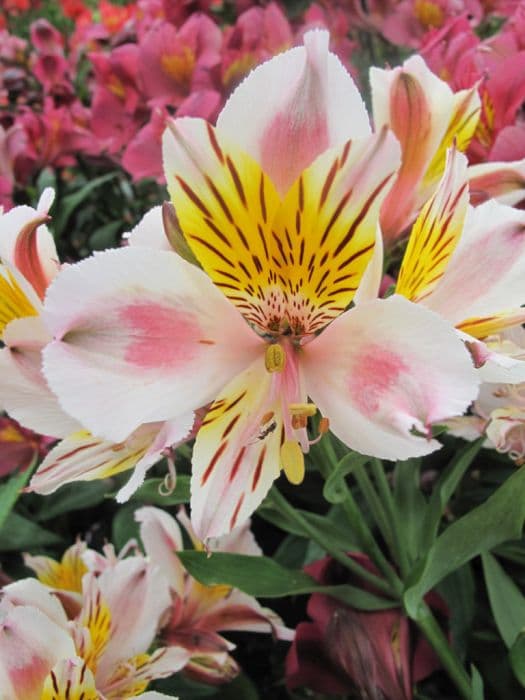
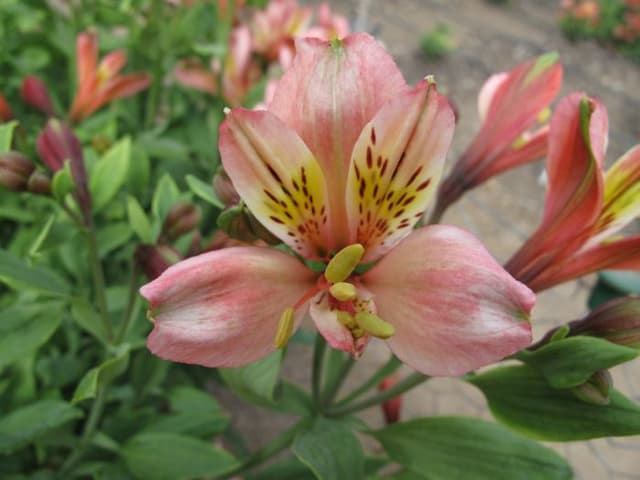
![Peruvian lily [Inca Glow]](/_next/image?url=https%3A%2F%2Fplants-admin.emdemapps.com%2Fimages%2Fplants%2F%2Fimages%2F604b5e99e48d9.png&w=640&q=75)
![Peruvian lily [Inca Smile]](/_next/image?url=https%3A%2F%2Fplants-admin.emdemapps.com%2Fimages%2Fplants%2F%2Fimages%2F604b5cad8fa91.png&w=640&q=75)
![Peruvian lily [Inticancha Passion]](/_next/image?url=https%3A%2F%2Fplants-admin.emdemapps.com%2Fimages%2Fplants%2F%2Fimages%2F604b5f7a78c8d.png&w=640&q=75)

![Peruvian lily [Summer Breeze]](/_next/image?url=https%3A%2F%2Fplants-admin.emdemapps.com%2Fimages%2Fplants%2F%2Fimages%2F604b6401573b7.png&w=640&q=75)

